

|
Back to |
| The Front Page |
| Letters & Opinion |
|
Frog and croquet have evolved together! Interview with Dr. John Blamire by Bob Alman Frog watercolors by John Blamire Posted September 25, 2012
|
Frogs are a hardier species than either human beings or iguanas. Until recently, all three species thrived at the National Croquet Center in West Palm Beach. While the iguanas were killed off in an unusually long cold spell five years ago--and several managers of the Center have tried to kill off the players there as well--the frog population continues to flourish, as seen each early spring in a spectacular frog migration out of the irrigation pond and into the greater world. Biologist Dr. John Blamire celebrates the hardiness of the frog species in all their glory along with his favorite sport in both wise words and brilliant watercolors.
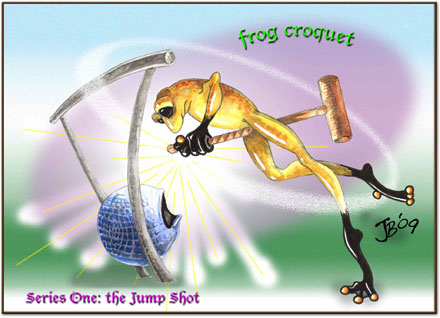
|
BOB ALMAN: John, your incisive portraits of these frogs suggests a degree of opinionation or bias on your part, not only on the characteristics of frogs as a species, but on croquet-playing frogs in particular, and finally on the traits of the individual frogs you have portrayed in these vivid watercolors. You might have chosen another amphibian, for example, such as the iguana--a beautiful beast in my opinion, more noble than the frog, which also has hung out at the National Croquet Center, where you play the game. So I guess I'm asking if these striking portraits show some of your racist tendencies, John--or perhaps I should say "species-ist" tendencies?
JOHN BLAMIRE: As a professional biologist/scientist/artist I can definitely assure you that it is almost impossible to define the word "species". I struggled with this issue my entire career, and never found an answer. Since I don't know what a "species" is, I am not sure how to answer your question, but ...
The frog is a noble beast. It was among the first creatures to claw its way out of the primal swamps billions of years ago and begin colonizing the land. It is also special in that it can breath through its skin, so it never has bad breath! Naturally, being one of the first creatures on land, it looked around for something to do to occupy its time while it waited for evolution to catch up with the lizards and iguanas. That is probably when croquet was invented.
BOB: I have many articles online already speculating on the "true" origins of our sport, but I've never heard that...
JOHN: Oh, yes. One may reasonably surmise that one of these frog pioneers bent over a reed and thus invented the first primitive "hoop". Since frogs are colorblind all the original croquet balls looked the same color, which made keeping track of a game very difficult, hence the evolution of frog-brains. Much higher intelligence was needed to play this game (like playing chess blindfolded), so frogs rapidly became the dominant land creature, and went on to invent culture, artifacts and moveable type--all because of croquet. We have found many fossilized frogs still clutching their mallets and reciting Shakespeare.
BOB: This is a real scoop, Dr. Blamire! Who but an evolutionary scientist could have ever figured out the link between the evolution of frogs and croquet! But why haven't we heard of this until now....?
JOHN: Perhaps its because when dinosaurs came along, frog croquet went into something of a hiatus, if not an actual decline in popularity among amphibians as pterodactyls kept swooping over the croquet lawns and carrying off tournament winners in their sharp, teeth-lined beaks (hence the original meaning of the croquet term "in the jaws"--it meant you were about to be eaten!).
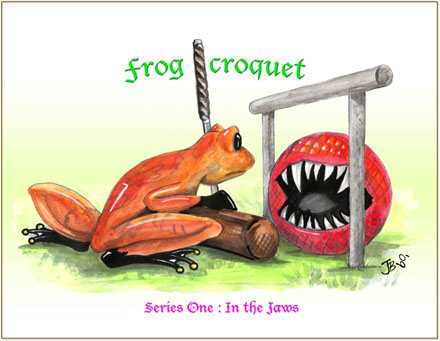
|
Fortunately, not all croquet-frogs were eaten by ancient reptiles or modern French diners, so the sport survived in the isolated rainforests of Antarctica until the continents collided sometime before Columbus arrived on these shores. Tentatively frog croquet players moved out of the Antarctic, past the giant meteorite crater that had just wiped out the dinosaurs, and into Florida where they found a croquet-friendly environment and the USCF waiting to greet them. Naturally, they took up residence and founded the FCC (Frog Croquet Club) where the sport became extremely popular among migrant toads from New York.
BOB: I've never heard of the FCC!
JOHN: That's probably because long after the biblical floods subsided, and sometime after Abraham Lincoln won the six-wicket tournament at Gettysburg against a scratch team from the South, the name was changed for politically correct reasons to the 'NCC' (where all amphibians, reptiles and lizards were welcome and included). What happened next is considered 'modern history' and is therefore of no interest to anyone.
BOB: I have to say, Dr. Blamire, after your sweeping tour de force history of our sport, that these revelations have until now remained hidden, even more obscure than the reported sightings of proto-croquet games among the Mayan ruins, or in ancient Egyptian tombs, where it's said that pyramid-shaped "balls" were used. But now that we're up to date, in the 21st Century here in South Florida, let's talk a little about the fascinating individual characteristics of the frogs in your croquet portraits. I can't help feeling that THE IRISH GRIP actually does play upon some unfortunate stereotypes. He's obviously a left-handed player--nothing wrong with that, with the strong hand correctly about to grip the mallet down the shaft, and the grip of the weak hand is correct, but it's clutching a beer mug, not a croquet mallet. And that frog has the biggest beer belly I've seen on anyone of any species, anywhere. Knowing your British roots, I feel I have to ask whether there's a degree of bias here...?
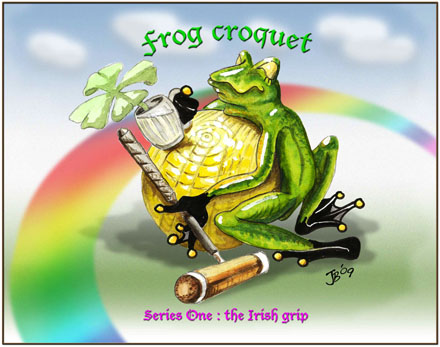
|
JOHN: I was fortunate recently to watch a golf croquet tournament played at the NCC that featured players from Egypt and Ireland. Irish players are among the best croquet aficionados in the world (if you don't count Australian sheep farmers!). It was a breath-taking pleasure to watch the champion from Ireland focus on the main elements of the game, hit roquets from across the court, casually shoot hoops from 20-plus feet away, and make it look easy! Naturally I studied this Irishman's style. It was clear to me, as I try to illustrate in my frog picture, that he had a close intimacy with the game and a studied affinity for the ball he was playing. He 'got to grips' with the yellow ball with such affection that I thought the milling would rub off.
BOB: OMG! I saw that big yellow expanse as a beer belly! Now I see it's the yellow ball!
JOHN: Yes, and naturally his balls responded obediently to this care and attention and with patterns of behavior that rewarded him mightily at the hoops. We could all learn something from this. Moreover, his grip on the mallet was casual, unstudied and with the swash and buckle of an amphibian Douglas Fairbanks (Junior or Senior). It's hard to capture or represent in a static image, but if you look closely at the frog's left hand, you will experience some of the insouciance.
BOB: I see now that this portrait is really loaded with symbolism, which you might like to explain.
JOHN: Behind the frog is a rainbow leading him to the pot of gold we all find as our balls finally click against the peg. His eyes are closed. He sees victory looming. All he needs is a bit of luck and one more opponent will have been charmed and defeated at the same time. The four-leaf clover/shamrock he holds in his right hand symbolizes the Irish love of the land, plants, Liffy Water and the quest for impossible dreams. We could all learn a lot from the Irish--especially their frogs!
BOB: All right, John, but don't tell me I'm making it up when I see in "At the Club" a measure of contempt for the "social" player, whose values are mostly associated with the clubhouse, and not the game...?
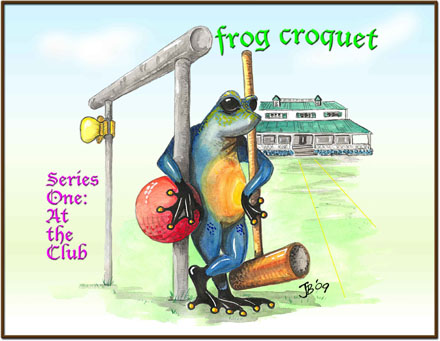
|
JOHN: Bob, if only you had picked up and read any one of my biology books--books that have instructed and informed countless generations of young minds concerning the behavior of amphibians--you would never have asked such a question. Frog-croquet players have complex social lives, evolved over many millennia and countless eons of time to ensure the survival of their species and keep biologists wondering "why do they do that?" It is an intriguing question and one that has confounded the halls of academia since the time Galileo first turned his telescope off the heavens and through the window of the local nunnery. Very revealing.
All mature frog-croquet players old enough to be past the age of consent are driven by forces of nature beyond their control to leave the NCC every summer and migrate north to distant lands, vistas, the Hamptons, and cheap motels beyond the boarders of Florida. This is their "social" time. Frogs without their mallets, and with other ideas on their minds, are very nervous and shy creatures, which is why it has taken so long for biologists to discover their secrets.
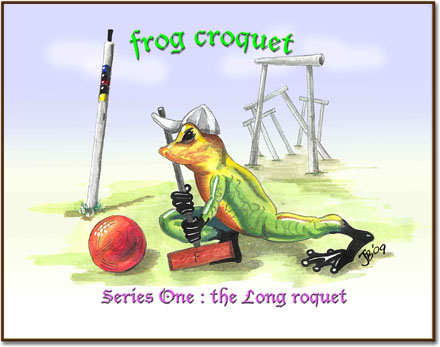
|
Using Galileo's telescope, so as not to disturb them, scientists have observed frogs slipping into pools of water to begin what can only be called one of the major social drives of nature. Modesty and the knowledge that this answer will be read by persons of a nervous disposition, mean I will draw a veil over what happens to frogs once they find themselves in water over their heads. If you have a vivid imagination, you can fill in the blanks.
BOB: I can appreciate all that, but what does that have to do with being a member of the NCC?
JOHN: I'm only explaining why frog-croquet players would never "socialize" in the NCC Club House. This would be a fatal social gaffe, never tolerated out of water. I have tried to be fair to social frog-croquet players and represent their activities in art form. Unfortunately every time I tried to paint watercolor sketches deep in the frog pools, the results were very washed out and not up to my standards - maybe in the next series.
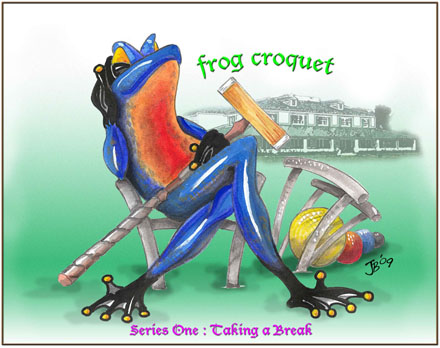
|
BOB: Now that you've instructed me in the social mores or frogs, I understand the seeming arrogance of the TAKING A BREAK. It's actually a cover for shyness! Thank you so much, Dr. Blamire, for including us not just in your closely-observed study of these frog species, but also in the very creative inferences connecting their development with the evolution of our sport.
JOHN: I have enjoyed helping you learn about the obscure but ultimately rewarding world of frog croquet. It is an area of human knowledge that needs more acolytes. In fact I have just had an idea for my next painting...
ABOUT JOHN BLAMIRE:
He retired in 2007 as Chairman of the Biology Department at Brooklyn College, where he had been a scientist, researcher and web-site innovator for about 35 years. Over the years, the research he did involved various aspects of molecular and cellular biology, including work on DNA long before it became a popular molecule.
John was born in the Northeast of England, where he met his wife, Anthea, at a high school barn dance. After leaving school he continued his education at Manchester University graduating with a B.Sc degree and three years later with a Ph.D (in cellular biology). He then worked for a time at the Albert Einstein College of Medicine (in the Bronx) with Julius Marmur (who is well known to all good DNA people).
When John retired he was determined to fulfill a life-long ambition and write fiction stories, after having already written his share of non-fiction science books. Some of his recent short stories are now available through the iBook Store, Barnes and Nobel, or Smashwords website in e-book form (try 'As It Was Told' - by John Hulme). He is currently on the fourth part of a historical novel that may be published in serial form one day.
According to John, "I started painting portraits in oil in the early nineties, but by then I was already quite good at Chinese watercolor painting, and I intend to get back to both media some day. Unfortunately, since I discovered croquet and the National Croquet Center, I have found less and less time for my 'other' artistic pursuits."
John and Anthea joined the NCC in 2007 and their addiction to the sport has steadily grown since then. He comments, "During the recent storm (Isaac), when we were trapped at home and could not get out and play, we watched croquet DVDs instead!"
He continues, "The Frog Croquet series of paintings/cartoons grew from a double source; my watercolor painting and my love of the sport. It seemed a strangely fitting combination. The ideas for the individual frames grew from a play on words and a natural distortion of reality when you pick up and run with the idea of a frog playing croquet".
There may be more in the works. He admits, "I would like to do a series about the various players and characters we have encountered, but I may change the technique a bit and I am working on that aspect first. We were inspired recently by a local exhibition of the works of Edward Gory at the Norton Museum."